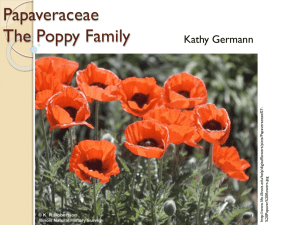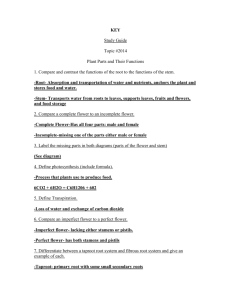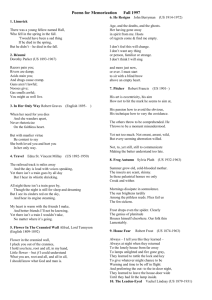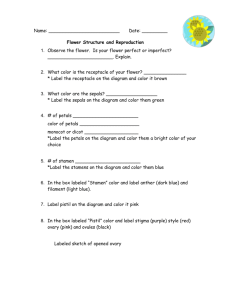Flower.fruit.inflorshort
advertisement
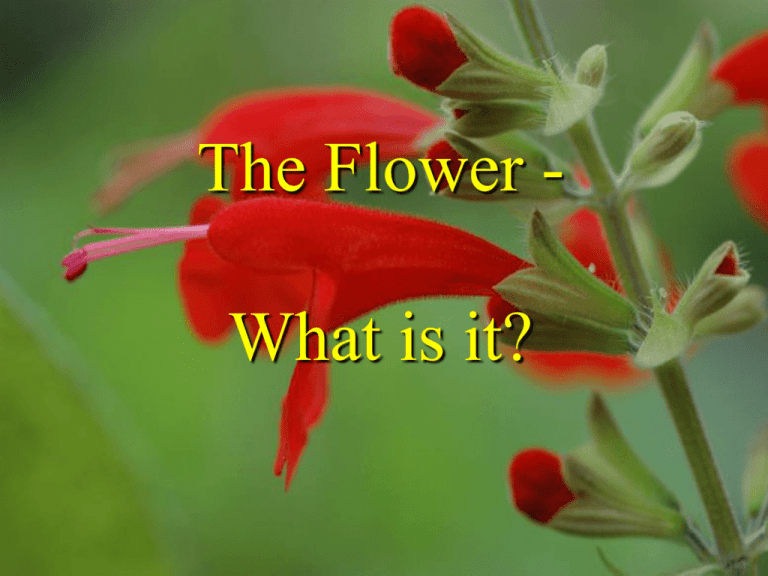
The Flower What is it? The Flower — What is it? • “foliar theory” of flower - J.W. von Goethe in “Attempt to Interpret the Metamorphosis of Plants” (1790) from Schleiden 1855 The Flower — What is it? • thus, a flower is a specialized shoot that: 1. is determinate (vs. indeterminate) 2. has a modified stem with compressed internodes 3. possesses modified leaves with various functions, these determined by gene arrays (e.g., ABC model) 4. often clustered in an inflorescence (larger branch) The Flower read chpt 9 in Plant Systematics! 1. Peduncle: floral stalk, the stem supporting the flower; sometimes referred to as the pedicel The Flower 2. Receptacle: modified floral stem or axis from which arise the floral appendages or modified leaves The Flower 3. Sepal: the outer whorl of leaves, green and protection; collectively called the calyx The Flower 4. Petal: the second whorl of leaves, typically brightly colored, attracting pollinators; collectively called the corolla The Flower 5. Perianth: collective term for sepals and petals Tepals if both similar The Flower 8. Stamen: the male structure of flower comprising filament and anther • collectively, stamens are the androecium (= ‘house of males’) • can be leaf-like in primitive angiosperms The Flower 6. Filament: slender stalk of the stamen supporting the anther; permits exsertion of pollen out of flower The Flower 7. Anther: fertile portion of stamen that dehisces to release pollen grains; composed of anther sacs The Flower Nectaries often near base of stamens • produce nectar reward for visitors who will move pollen (‘pollinators’) e.g., grass-of-parnassus & fritillary The Flower 13. Pistil: flask-shaped, female structure comprising three main parts • often referred to as carpel(s) • all pistils (1 or more) are referred to as the gynoecium (= ‘house of females’) The Flower 9. Ovary: basal portion of pistil that contains ovules; at maturity becomes fruit with seeds 10. Ovules: fertile portions of pistil that contain a female gametophyte (embryo sac); develop into seeds after fertilization The Flower 12. Stigma: receptive portion at top of style that receives and recognizes pollen 11. Style: slender stalk of pistil above ovary that the pollen tubes must pass through to reach eggs in ovules The Flower Pollination biology Study of the pollen, its transfer, and movement down the style The Flower Pistil vs. carpel How do you know? 3 examples Carpels not fused 1. Monocarpic 2. Apocarpic Carpels fused 3. Syncarpic Monocarpic The Flower 1 floral ‘leaf’ in gynoecium Folded ‘leaf’ 1 carpel = 1 pistil This gynoecium is monocarpic (one carpel) The Flower 1 carpel = 1 pistil legumes This gynoecium is monocarpic (one carpel) The Flower Apocarpic • If 9 ‘leaves’ in one flower each separately forms carpels, • then the flower has 9 carpels and 9 pistils, • gynoecium is apocarpic (separate carpels) Caltha palustris - Marsh marigold 9 fruits (pistils) from 1 flower Gynoecium is apocarpic with 9 carpels or 9 pistils The Flower Syncarpic 3 floral ‘leaves’ in gynoecium fuse 3 carpels = 1 pistil 3 styles This gynoecium is syncarpic 3 carpels = 1 pistil 1 style This gynoecium is syncarpic The Flower Placentation types - arrangement of ovules, provides hints to the number of carpels Marginal - found in all monocarpic or apocarpic pistils Axile - found in some syncarpic pistils The Flower Placentation types - arrangement of ovules, provides hints to the number of carpels Parietal - found in some syncarpic pistils The Flower Placentation types - arrangement of ovules, provides hints to the number of carpels Parietal - found in some syncarpic pistils Free-central - found in a few syncarpic pistils The Flower Placentation types - arrangement of ovules, provides hints to the number of carpels Parietal - found in some syncarpic pistils Free-central - found in a few syncarpic pistils Basal - found in some monocarpic, apocarpic, or syncarpic pistils The Flower Symmetry plan - perianth arrangement important in pollination biology Flowers radially symmetrical Flowers bilaterally symmetrical Flowers actinomorphic Flowers zygomorphic The Flower Connation: fusion of floral parts from the same whorl Fusion of carpels Fusion of stamens Syncarpic pistil Staminal tube Fusion of petals Corolla tube The Flower Adnation: fusion of floral parts from different whorls No adnation! Connation (fusion of similar parts) may or may not occur The Flower Adnation: fusion of floral parts from different whorls Adnation of calyx, corolla, & stamens = hypanthium The Flower Adnation: fusion of floral parts from different whorls Inflorescences - Floral Displays The vast majority of flowering plants possess flowers in clusters called an inflorescence. These clusters facilitate pollination via a prominent visual display and more efficient pollen uptake and deposition. A shift from widely spaced single flowers to an inflorescence required condensation of shoots and the loss of the intervening leaves. The simplest inflorescence type would thus be indeterminate with the oldest flowers at the base and the younger flowers progressively closer to the apical meristem of the shoot. Raceme (Prunus or cherry) = a raceme One modification of the basic raceme is to make it compound compound Raceme Panicle The panicle is essentially a series of attached racemes with the oldest racemes at the base and the youngest at the apex of the inflorescence. Panicle (Zigadenus or white camass) A second modification of the basic raceme is to lose its pedicels Pedicel loss Raceme Spike The spike is usually associated with congested reduced flowers and often, but not always, with wind pollination. wind pollinated Spike (Plantago or plantain) animal pollinated The spike is usually associated with congested reduced flowers and often, but not always, with wind pollination. Spike (Combretum - Brent’s plants) Besides these indeterminate inflorescences based on the raceme, there is a series of inflorescence types based on determinate shoots (shoot can not grow up indefinitely). The simplest is the dichasium. Raceme Dichasium The dichasium inflorescence is terminated (i.e., determinate) by the oldest flower and flanked by two lateral younger flowers. oldest flower Dichasium younger flowers (Clematis or virgin’s-bower)


